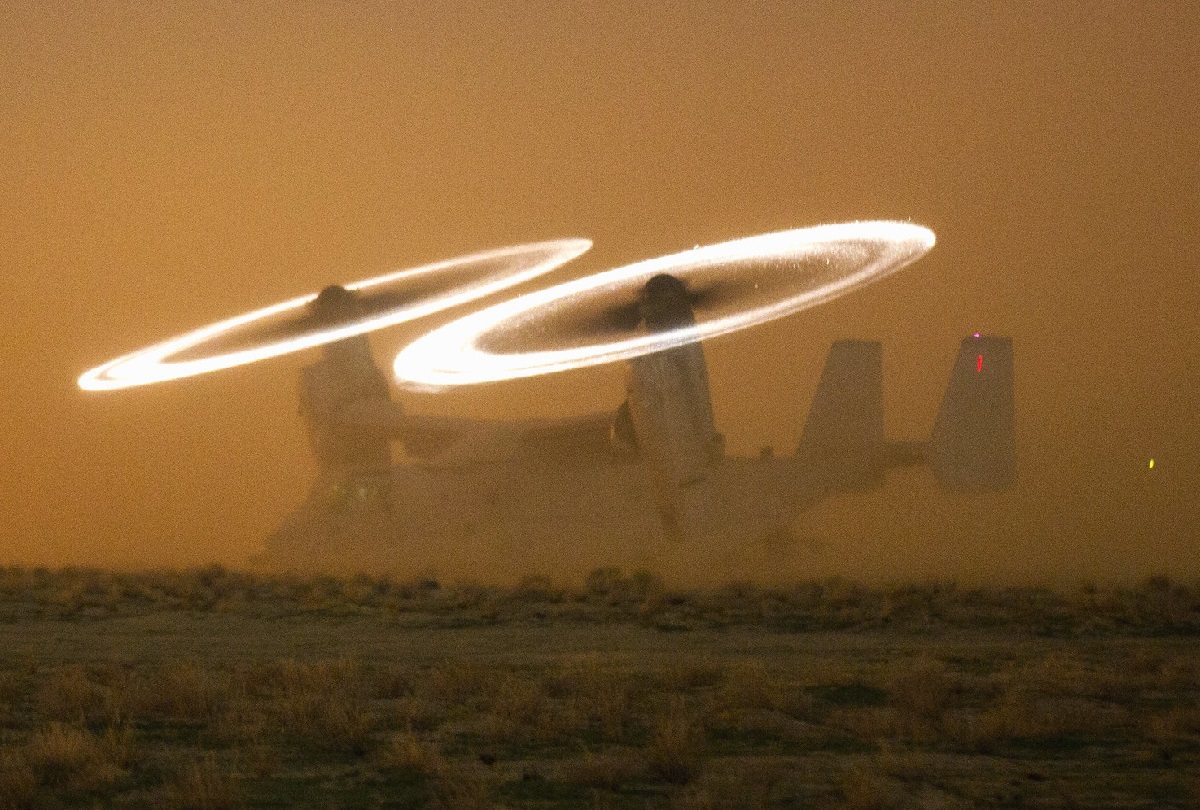The V-22 Osprey may be the most easily recognizable airframe in the entire US military inventory. With tiltrotors, the V-22 is essentially a mash-up between a helicopter and a turboprop aircraft. Capable of conducting both vertical takeoff and landing (VTOL), plus short takeoff and landing (STOL), the V-22 combines the high-function of a helicopter with the high-speed and long-range of a turboprop. Typically, the V-22 takes off and lands as a helicopter – with its nacelles vertical and its rotors horizontal. Then, once airborne, the nacelles rotate forward 90 degrees in about 12 seconds and then V-22 flies in horizontal flight.
In 1980, US President Jimmy Carter authorized Operation Eagle Claw to rescue US citizens held hostage at the Embassy of the United States in Tehran, Iran. The operation was aborted on account of helicopter failures. While eight helicopters were sent to the mission’s first staging area, Desert One, only five arrived in operational condition. Only four helicopters were absolutely necessary to complete the mission, but protocols dictated that the mission would be aborted if less than six helicopters were available. Military advisers pressured Carter to abort the mission, which he did. Political rivals, especially Ronald Reagan, often cited Carter’s abort decision as evidence that Carter was a weak leader. The failure of Operational Eagle Claw is cited as a prime reason for Carter’s 1980 election defeat. Carter, now in his 90s, still rates failing to launch additional helicopters during Eagle Claw as one of his biggest regrets. Perhaps never before (or since) had helicopters been so influential or consequential in such a concentrated manner. US war planners believed Eagle Claw demonstrated concretely the need for “a new type of aircraft, that could not only take off and land vertically but also could carry combat troops, and do so at speed.” Something that could have gotten the job done for an operation like Eagle Claw. Something like the V-22.
In 1981, inspired by the technological deficiencies laid bare during Eagle Claw, the Department of Defense initiated the JVX aircraft program. JVX incorporated design requirements from the Army, Navy, Air Force, and Marine Corps. Several companies, including Aerospatiale, Bell, Boeing, Grumman, Lockheed, and Westland expressed interest in the project. Only one proposal was received, however – from Bell and Boeing, who had teamed up to satisfy the project’s demanding specifications. Without competition, Bell Boeing was awarded a contract in 1983.
Bell and Boeing split the new aircraft’s design somewhat evenly. Bell took responsibility for the wing, nacelles, rotors, drive system, tail surfaces, and aft ramp. Bell was also charged with integrating the Rolls-Royce engine. Meanwhile, Boeing took responsibility for the new aircraft’s fuselage, cockpit, avionics, and flight controls. In 1985, the JVX aircraft was redesignated as the V-22 Osprey. Six prototypes went into development. And then things got complicated.
In 1988, the V-22 was displayed publicly for the first time. Also, in 1988, the Army abandoned the project, stating they needed to dedicate their finite budget to more immediate aviation programs. In 1989, the US Senate began targeting the V-22 program; twice the Senate voted on whether to cancel the V-22 program – but the Senate declined to cancel the V-22. The Department of Defense picked up the mantle, however, exerting pressure to end the V-22 as program costs increased. The DoD instructed the Navy to stop spending money on the V-22; then-Secretary of Defense Dick Cheney spent three years, from 1989 to 1992, trying to defund the V-22 – but Congress intervened. Congress was impressed with studies that had shown the V-22’s capability and effectiveness were worth the investment. When the Clinton Administration entered the White House, they agreed: the V-22 was worth funding.
Flight testing of the V-22 had problems, too. Of the six prototypes built, two crashed during flight testing. The aircraft was grounded while redesigns meant to increase safety were incorporated. Additionally, changes were made to reduce empty weight, simplify the manufacturing process, and reduce building costs. The newer, safer, cheaper variant debuted in 1993.
In 2000, two more fatal crashes killed a total of 23 US Marines. The V-22 was grounded again. The crashes were investigated. Safety-based redesigns were incorporated. But at this point, the V-22 had been in development for nearly two decades. The V-22 had a spotty safety record and as was becoming apparent – it was an expensive platform.
The V-22’s “production costs are considerably greater than for helicopters with equivalent capability – specifically, about twice as great as for the CH53E, which has a greater payload and an ability to carry heavy equipment the V-22 cannot,” Michael E. O’Hanlon, a senior fellow at the Brookings Institute wrote. “An Osprey unit would cost around $60 million to produce.”
Still, in 2005, the Pentagon approved full-scale production – making the V-22 the first tiltrotor aircraft to ever enter production. Now, the Pentagon has announced that V-22 production will soon end.
Harrison Kass is the Senior Defense Editor at 19FortyFive. An attorney, pilot, guitarist, and minor pro hockey player, he joined the US Air Force as a Pilot Trainee but was medically discharged. Harrison holds a BA from Lake Forest College, a JD from the University of Oregon, and an MA from New York University. He lives in Oregon and listens to Dokken. Follow him on Twitter @harrison_kass.

